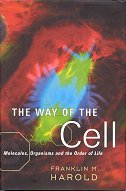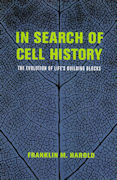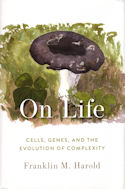This is a profound and enlightening book, illustrating what a
non-reductionist biology needs to encompass.
p224.
If organisms are ever to be understood
as material physical entities, physics will first have to be
transformed into a science of complex systems.
Harold achieves this without ever going beyond the single cell: that
has sufficient complexity, self-organisation, and epigenetic features
of its own to more than make his point.
p17.
the cell represents the simplest level
of organization that manifests all the features of the phenomenon of
life.
This book is not an easy read: I found that I had to digest it
slowly over a period of several months, partly because of the depth of
the concepts, partly because of the sheer mind-boggling complication
and detail of the subject matter. For, despite Harold claiming to have
taken pains to ensure that the biology is intelligible to
non-biologists (and it certainly is much more intelligible
than the average biology journal paper), there is still a dense soup
of technical terms, not always explained in advance. However, the
effort needed to unpack this is more than worthwhile.
Harold slowly builds up his argument, by showing us cells in all
their amazing complexity, subtlety, and variety.
p26.
prokaryotes have evolved so as to
exploit the full range of energy sources available on earth. We find
among them aerobes and anaerobes, all the known kinds of
photosynthesis ..., the capacity to oxidise H2, H2S
and Fe2+, to reduce sulfate to sulfide and CO2
to methane, and also the machinery for nitrogen fixation.
Biology is at heart an historical science -- the
evolutionary route life has taken is important.
p218.
Organisms are historical creatures, the
products of evolution; we should not expect to deduce all their
properties from universal laws. ... We are gravely hampered by having
but a single kind of life to ponder
However, at the end of Harold's argument, we see that there is more
to explaining the activity of life than by reference to readings of
its genetic code, and more to explaining its current form than terms
of evolution alone -- function and physics also play important roles
in this explanatory task.
p111.
Knowledge of the genes and what they
encode is nowhere near sufficient to explain how the cell elongates,
divides and shortly produces a pair of rods with rounded caps. What we
seek to understand emerges from the sociology of molecules, not their
chemistry, and carries us into a different layer of reality. ... A
growing cell is not a self-assembling set of puzzle pieces, but the
product of generative processes mediated by multiple molecules,
physiological pathways deployed in space. The reactions that shape a
cell have, of course, a chemical dimension; but unlike their fellows
in the test tube, many of them display direction, location and timing.
p224.
natural selection is not the sole source
of order in the living world, but complements order that arises by the
self-organization of complex systems.
Harold shows how biology is the science of both informatics and
of physics, in addition to being historical. It is where the laws of
informatics governing genetic and other information processing devices
combine with the laws of physics governing complex dynamical systems
in complex phase spaces of physical structures, with its contingent
events all being played out over a vast historical timespan.
p39.
Transport proteins carry matter;
receptors deal in information. ... The role of membranes ... is dual:
they separate components while channeling the flow of matter and of
information.
p52.
energy is the power to do, information
is the power to direct what is done
p69.
Genes specify the cell's building
blocks; they supply raw materials, help regulate their availability
and grant the cell independence of its environment. But the higher
levels of order, form and function, are not spelled out in the genome.
They arise by the collective self-organization of genetically
determined elements, effected by cellular mechanisms that remain
poorly understood. If the genome is a kind of software, it takes for
granted the existence of a particular and unique decoder.
Because of all this complexity, not to mention much evidence being
lost in the mists of time, Harold does not believe that we are as near
to an understanding of life as some of the more optimistic pundits.
The answers are at best partial, and may always remain so.
p232.
To the question, What is Life?, science
presently offers two answers. The first asserts that living organisms
are autopoietic systems: self-constructing, self-maintaining, energy
transducing autocatalytic entities. The alternative answer proclaims
that living organisms are systems capable of evolving by variation and
natural selection: self-reproducing entities, whose forms and
functions are adapted to their environment and reflect the composition
and history of an ecosystem. The two answers are not identical, but
there is substantial overlap between them; they emphasize different
aspects of a rounder reality. ... The best answer we can offer at
present combines both partial ones: life is the property of
autopoietic systems capable of evolving by variation and natural
selection.
But Harold is not dismayed by this. For, after all,
p236.
the unique claim of science is not that
it has all the answers but that it knows the questions, and will not
compromise its commitment to the rational search for truth.
Further selected quotes:
p12.
Sharp categories are generally something
that we put into nature, not something we find there.
p13.
No biological phenomenon can be said to
be understood until we have found both its functional and its
evolutionary explanation---and each of these is sure to be
multilayered.
p13.
even a machine is not explained by
mechanical principles alone, for its construction is guided by the
designer's purposes which constrain the blind operation of physical
laws. In the case of living organisms, it is their hierarchical
organization and their origin in the interplay of random variation and
natural selection that should give pause to any radical reductionist.
p15.
living things are wholly composed of
molecules, and everything they do finds a mechanistic explanation in
terms of the actions and interactions of their constituent molecules.
But their organization into systems of mounting complexity guarantees
the emergence of supra-molecular structures and activities. The more
advanced the level of organization, the less informative is it to seek
understanding solely in terms of their molecular constituents. It
makes little sense to seek the molecular basis of hibernation because
that is inherently the function of an organism (though one may hope to
find genes and proteins specifically involved in hibernation).
p28.
prokaryotes make up the "unseen
majority" of life as judged by biomass as well as cell numbers
p28.
the volume of a eukaryotic cell is
typically a thousand times large than that of a prokaryotic one. ...
It seems likely that the complex architecture of eukaryotic cells,
especially their extensive system of endomembranes, represents an
adaptation to their larger size.
p52.
The diversity of regulatory devices is
far greater than that of the processes which are subject to
regulation.
p53.
The use of multiple, unrelated, and
redundant regulatory devices is quite typical; the object of the
exercise is not simplicity and elegance, but to make both the activity
and the production of the enzymes ... exquisitely sensitive ....
Control circuits, particularly those seen in eukaryotic cells, are
more elaborate than the processes which are regulated, and commonly
involve many more components. ... a large share of the cell's genetic
information must be devoted to the production of regulatory elements.
p58.
no one has discovered a persuasive
chemical connection between any particular triplet of nucleotides and
the amino acid that this triplet codes for.
p61.
the major source of evolutionary novelty
now appears to be gene duplication, followed by progressive divergence
p73.
the cellular context impinges upon the
transfer of information, for the [amino acid] chain will only fold "correctly"
in a medium of "appropriate" ionic composition and pH.
p93.
To make [network]
adaptation robust, the rates ... must be
modelled as functions of the ... activity of the complex, not of the
concentration of the proteins.
p101.
it takes no less than forty minutes to
replicate the genome; cells manage nevertheless to divide every twenty
minutes, by initiating new rounds of replication before the first one
has finished. Consequently a fast-growing cell ... represents two
cells about to become four.
p104.
A growing cell is a vessel under
pressure---about 5 atmospheres in the case of E. coli,
comparable to the air pressure in a racing bicycle tire.
p114.
Every cell comes from a parent cell,
which provides a templet upon which the daughter cell is modeled; and
the parent cell's epigenetic landscape acts in concert with its genes
to guide the process of reproduction. New gene products ... are
generated in a context that already possesses a degree of spatial
structure, and they take their places in an existing order.
p124.
the cytoskeleton holds together thanks
to the continuing expenditure of energy, and it is subject to frequent
remodelling. ... Everything is in flux, but in a regulated purposeful
manner. Neither morphogenesis nor any other cellular activity of
eukaryotic cells can be understood apart from the cytoskeleton.
p142.
form and function in amoeboid cells do
not depend on a particular set of molecular players ... Any suite of
molecules will do, so long as they can be articulated into cellular
structures that support the function at hand. Form grows out of this
organization of molecules, not their chemistry
p143.
The continuing effort to learn how
ciliates position cortical organelles during growth, development and
regeneration has provided incontrovertible evidence that such patterns
are not spelled out in the genome. Instead, the placement of new
cellular structures is directed by existing ones: structure begets
structure.
p145.
structural guidance is a common mode of
pattern formation ... there are many examples of modifications that
are transmitted from one generation to the next, not by way of the
genes but because they are linked to a cellular structure that
persists through cell duplication.
p150.
Dynamic systems are characteristically
maintained in a state remote from equilibrium by a continuous flow of
energy. ... physical systems of this kind commonly undergo spatial
self-organization, with concurrent enhancement of the energy
throughput ... [it] coordinates the random motions of innumerable
particles over an extended territory, and may persist indefinitely so
long as the supply of matter and energy lasts.
pp159-160.
the fundamental patterns of metabolism,
heredity and structural organization were all fixed during that vast
span of three billion years when the earth was populated exclusively
by microorganisms.
pp162-3.
The trademark of prokaryotes is
metabolic diversity. ... Where eukaryotes excel ... is in the
diversity of shapes, lifestyles and adaptations, their speciality is
organization.
p167.
The cyanobacteria went on to generate
the bulk of the atmosphere's oxygen, and became the progenitors of
eukaryotic chloroplasts.
p175.
in the absence of discrete organisms and
lineages, evolution in its earliest stages was quite unlike that with
which we are familiar: its topology had the character of a net rather
than a branching tree.
p203.
novelty arises from three sources: gene
duplication and divergence, symbiosis and epigenesis
p205.
Genes did not necessarily arise where
they are found, they may have been imported. There is something
disturbing about the notion that genes can be transferred from one
species to another, let alone between phyla and kingdoms. It violates
one's sense of organismal integrity, and calls into question the
principle of a lineage defined by the vertical transmission of genes
from parent to offspring. But horizontal transfer happens, on a scale
that ranges from single genes to entire genomes; it represents a major
source of evolutionary novelty, and a significant enlargement of the
modern synthesis. One such kind of lateral gene transfer has become
painfully familiar: the spread of antibiotic resistance among
pathogenic bacteria. ... the genes that confer resistance ... cluster
on plasmids ... that pass easily from one bacterial tribe to another.
p206.
the wholesale melding of lineages ... "symbiosis"
p211.
developmental plasticity widens the
range of phenotypes, providing a richer assortment of variants on
which selection can act. … evolution is facilitated by a cellular
design that loosens the linkage between genotype and phenotype ... the
key building blocks have been strongly conserved … organisms
diverge by rearrangement of the regulatory circuitry. Regulation is
typically mediated by proteins that are relatively unspecialized and
can be fitted for new functions with a small number of mutational
changes. … in eukaryotes gene transcription is controlled by
multiple proteins that interact weakly with DNA and with each other;
new proteins bearing additional messages can be added on and summed up
with the prior ones.
p221.
The informational metaphor is ... a ...
half-truth ... Organisms process matter and energy as well as
information; each represents a dynamic node in a whirlpool of several
currents, and self-reproduction is a property of the collective, not
of genes. Form, structure and function are not straightforward
expression of the gene's dictates; there is more to heredity than what
is encoded, and you can only go from genotype to phenotype by way of
epigenetics. DNA is a peculiar sort of software, that can only be
correctly interpreted by its own unique hardware. ... The
informational metaphor all but ignores the multiple webs of
relationships that make up physiology, development, evolution and
ecology.
p222.
one of the perennial topics in the
literature is just what makes a system complex, as distinct from
merely complicated. Formalities aside, complexity is not hard to
recognize and is commonly more a matter of degree than of kind.
Diagnostic features include the emergence in the system as a whole of
properties that cannot be assigned to any one of its components,
invariance of the whole even though its components fluctuate, and a
complementary interplay between local causes and global ones, such
that each level constrains the other. Complex systems are commonly
(though not necessarily) dynamic rather than static, and open to the
input of energy and matter from the environment. Above all, they
always display "some kind of non-reducibility: the behavior we
are interested in evaporates when we try to reduce the system to a
simpler, better-understood one".
pp222-3.
Robert
Rosen … has spelled out what the irreducibility of complex
systems consists of. First, a complex system cannot be fractionated:
there is no one-to-one relationship of parts to functions because one
or more of the parts play several roles at once. Second, while aspects
of a complex system may have simple mechanistic descriptions, there
exists no such description that embraces the system as a whole. Third,
even those apparently simple partial functions change over time and
diverge from what would have been their behavior in isolation. For all
those reasons, complex systems are in principle not wholly reducible
to simpler ones, and the Newtonian paradigm cannot be applied to them.
p223.
what then defines the subclass of
complex systems to which organisms belong? Rosen seeks criteria that
will be universally applicable to any form of life, even to life
beyond the solar system or to fabricated organisms. Such criteria will
be independent of any particular material incarnation, and must be
drawn from those abstract principles of organization that make living
systems living. …
... "A material system is an
organism if, and only if, it is closed to efficient causation" …
if f is any component of a living system and we ask what is
the cause of f the question has an answer within the system. …
in Rosen's view evolution is secondary: one can imagine life forms
that did not evolve (e.g., fabricated ones), but evolution without
life is inconceivable.


